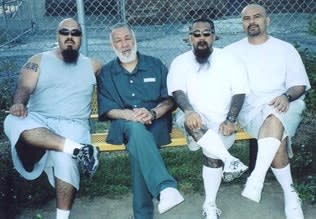Southern California's Orange County has the reputation as a conservative, largely affluent, cluster of bedroom communities populated mostly by Caucasian families. However, minority enclaves and street gangs have dotted the Orange County area from the beginning, especially around Santa Ana. There was money to be made trafficking in narcotics in these minority enclaves and especially the affluent communities with expendable incomes. Criminal gangs established themselves early on. Many of these street gangs had ties to Mexican sources for narcotics in nearby San Diego and across the border.
Peter "Sana" Ojeda was an "old school" veteran of the traditional Latino street gang called F-Troop, and his moniker "Sana" was short for Santa Ana. This gang could trace its beginnings to the Pachuco gangs of 1940s and '50s. Sana was also an early member of the Mexican Mafia prison gang.
I've had several opportunities to arrest Sana Ojeda over the years as a member of the Los Angeles County Sheriff's Prison Gang Unit assisting the California Department of Correction (CDC) in raids targeting Ojeda and his gang. Each time we arrested Sana Ojeda I wondered how this burned-out old hype (heroin addict) could be such a powerful gang leader in Orange County and within the Mexican Mafia. The Mexican Mafia had regulations about this kind of addiction and abuse of "chiva" (heroin). But it was this same enslaving black-tar heroin that secured Sana's power. He was a source and conduit for this money making product. This poison bought him power and influence.
Sana surrounded himself with gang members who were loyal to the Mexican Mafia, but especially loyal to Peter "Sana" Ojeda. He made sure that anyone from Orange County who might be considered for membership in the EME was someone in Sana's debt and beholden to his wishes.
In 1992, Sana Ojeda had organized the first meetings of the representatives of the numerous warring Latino Orange County gangs in El Salvador Park. He and his Mexican Mafia supporters ordered the gang taxation, race wars and "no drive-by" policies that were later replicated in San Diego, Los Angeles, San Bernardino and Kern counties.












